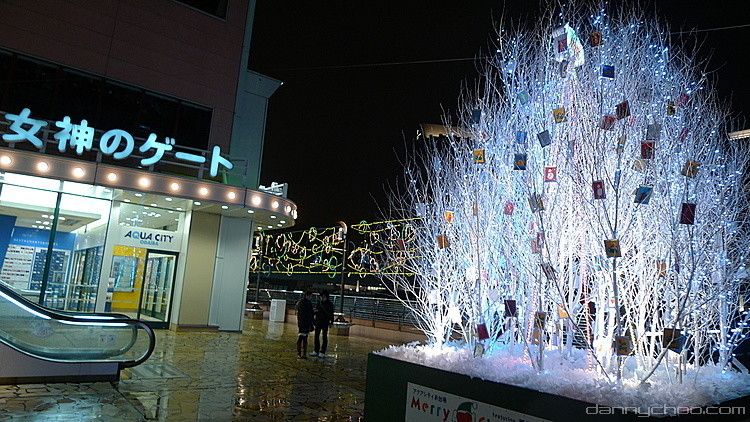7pm in Tokyo - Odaiba
Just got back from having dinner in Odaiba and went out on the decks to catch some of the festive illuminations. At this time of evening it took us 30 mins to get there by car. Using the highway would get us there 10 mins quicker but cost an extra 700 yen to use.
Interesting history about Odaiba from Wikipedia...
The name Odaiba comes from a series of six island fortresses constructed in 1853 by the Tokugawa shogunate in order to protect Edo from attack by sea, the primary threat being Commodore Matthew Perry's Black Ships which had arrived in the same year. Daiba in Japanese refers to the cannon batteries placed on the islands. In 1928, the Dai-San Daiba (第三台場) or "No. 3 Battery" was refurbished and opened to the public as the Metropolitan Daiba Park, which remains open to this day.
The name Odaiba comes from a series of six island fortresses constructed in 1853 by the Tokugawa shogunate in order to protect Edo from attack by sea, the primary threat being Commodore Matthew Perry's Black Ships which had arrived in the same year. Daiba in Japanese refers to the cannon batteries placed on the islands. In 1928, the Dai-San Daiba (第三台場) or "No. 3 Battery" was refurbished and opened to the public as the Metropolitan Daiba Park, which remains open to this day.
From the originally planned 11 batteries, only five were ever finished. The modern island of Odaiba began to take shape when the Port of Tokyo opened in 1941. Until the mid 1960s all except two batteries were either removed for unhindered passage of ships or incorporated into the Shinagawa port facilities and Tennozu island. In 1979 the then called landfill no. 13 (now Minato-ku Daiba, Shinagawa-ku Higashi-Yashio and Koto-ku Aomi districts), was finished directly connecting with the old "No. 3 Battery". "No. 6 Battery" was left to nature (landing prohibited).
Tokyo governor Shunichi Suzuki began a major development plan in the early 1990s to redevelop Odaiba as Tokyo Teleport Town, a showcase for futuristic living, with new residential and commercial development housing a population of over 100,000. The redevelopment was scheduled to be complete in time for a planned "International Urban Exposition" in spring 1996.
Suzuki's successor Yukio Aoshima halted the plan in 1995, by which point over JPY 1 trillion had been spent on the project, and Odaiba was still underpopulated and full of vacant lots. Many of the special companies set up to develop the island became practically bankrupt. The collapse of the Japanese asset price bubble was a major factor, as it frustrated commercial development in Tokyo generally. The area was also viewed as inconvenient for business, as its physical connections to Tokyo—the Rainbow Bridge and the Yurikamome rapid transit line—made travel to and from central Tokyo relatively time-consuming.
The area started coming back to life in the late 1990s as a tourist and leisure zone, with several large hotels and shopping malls. Several large companies including Fuji Television moved their headquarters to the island, and transportation links improved with the connection of the Rinkai Line into the JR East railway network in 2002 and the eastward extension of the Yurikamome to Toyosu in 2006. Tokyo Big Sight, the convention center originally built to house Governor Suzuki's planned intercity convention, also became a major venue for international expositions.
- Akihabara News - Gadgetry from Japan (Subscribe)
- Japan Probe - Japan news and entertainment (Subscribe)
- Kirainet.com - A geek in Japan (Subscribe)
